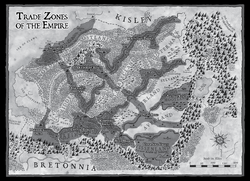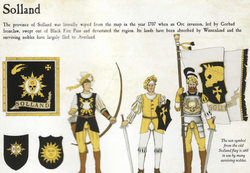Solland, formerly the Grand Barony of Solland and the Grand Barony of Sudenland, was once one of the southernmost Electoral Provinces of the Empire before losing that status in 2512 IC. The territory it once held dominion over is now called Sudenland or Old Solland and has been officially incorporated as a region of the province of Wissenland.[8a]
Destroyed by an Orc Waaagh! commanded by the Warlord Gorbad Ironclaw, the province was devastated and its ruling Elector Count slain in 1712 IC. For centuries, Solland lacked a proper feudal government until Emperor Magnus the Pious reformed Solland into the Grand Barony of Sudenland in 2305 IC, incorporating even some regions of southern Wissenland into Sudenland the process, a decision which angered many Wissenlanders.[8a]
For centuries, Sudenland was ruled by House Toppenheimer until the events of the Turmoil of 2512 IC. During that crisis, Wissenland and Sudenland came into conflict as Reikland-aligned factions in Nuln sought the annexation of the province. Surprisingly supported by the eight children of the then-Elector Countess Etelka Molrella of House Toppenheimer, Wissenland was able to fully annex all the territories of Sudenland during the great administrative reshaping of the Empire's Electoral Provinces that followed in the wake of that political crisis.[8a]
The province is named after its namesake, the River Sol, which acts as the traditional border between western Wissenland and eastern Sudenland.[5a]
History[]
Solland was originally the home of the tribe of Men known as the Menogoths, who joined Sigmar during the reign of their king Markus.[1a] Its symbol was the sun, which was incorporated into nobility crests and is even in use today.[4a] At the onset of the Age of Wars after the death of Mandred Skavenslayer, the Electors chose Otto of Solland as the next Emperor because of his weak character. Otto was unable to rein in the Elector Counts and, after his death, the office of Emperor became a mere trophy to be traded among the Elector Counts without any real authority.[1b]
The original province of Solland and their Elector Count Eldred were lost when a massive Orc Waaagh!, led by Gorbad Ironclaw in 1707 IC, attacked the province in a tide of violence. The Solland Runefang Grudge Settler was seized by the invaders after the Battle of Solland's Crown and it is said that Gorbad ripped off the crown of Solland from the head of the slain Elector Count and placed it on his own head.[2a][3a] The Runefang was retrieved centuries later by a joint group of Men and Dwarfs under Dwarf Thane Ergrim Stonehammer from the lair of a chimera in the Worlds Edge Mountains. Stonehammer presented it to the Emperor in Altdorf, who placed it in the Imperial Treasury.[6a][7a]
For centuries, the lands laid in ruins until Magnus the Pious ordered the reformation of the province in 2302 IC, renaming it the Grand Barony of Sudenland. For centuries, the newly established province lasted until the Turmoil of 2512 IC, when Wissenland dissolved the province and annexed its territories.[8a]
In the modern Empire, the lands east of the Sol are sometimes referred to as "Old Solland" or "Sudenland".[1c] Some nobles originating from the original province refuse to accept Wissenland's claim and use the term Sudenland in opposition to the claim of the Wissenland Elector.[6b] This region is famed for its wool and the furs trappers bring from the Black Mountains.[1d]
The Land[]

A map showing the former territory of Solland in Wissenland
Far to the south, almost out of sight and often out of mind of the rest of the Empire, sits the Grand Province of Sudenland, ruled by the Grand Baroness Etelka Morella von Toppenheimer. One of the newest Grand Provinces, Sudenland was created by Magnus the Pious in 2305 IC from the ruins of lost Solland, devastated in Gorbag Ironclaw’s invasion of 1712, and the southern half of Wissenland, something Wissenlanders in both provinces still resent. Shaped like an arrowhead, Sudenland lies between the Worlds Edge Mountains to the west, the Upper Reik and Averland to the east, and Nuln to the north. The Black Mountains and the Dwarf kingdoms including Khazid Hafal, Karak Gantuk, Karak Hirn, and Karak Anghazhar form its southern boundaries.[8a]
It rises from rich farmland in the area of Pfeildorf for about 100 miles to the south, then climbs gradually through lightly wooded hills into lands dedicated to cattle and sheep-raising in the foothills of the Black and Grey Mountains. There mining takes over, with rich veins of copper, tin, and gold — though the Dwarfs claim the gold is stolen from their lost mines and tombs. As Sudenland is seen as a backwater, most trade with outsiders is conducted in Pfeildorf at the great Marktplatz where the Söll and Upper Reik converge. The rivers are crucial to Sudenland’s economy, with ore and finished goods travelling by barge from upriver ports as far as Mendelhof and Kroppenleben. This makes them rich targets for river pirates, and so the Grand Baroness maintains a strong force of Riverwardens.[8a]
Sudenland controls a State Army consisting of, in addition to the Grand Baroness’ household cavalry and the town militias, a light infantry made up from the Road Wardens and Riverwardens, as well as axe-and-hammer wielding infantry from Vennland to the south. In times of crisis, the Grand Baroness can invoke treaties to summon contingents from the Dwarf Holds, though the Dwarfs successfully demanded clauses ‘keepin’ us out of your silly civil wars’. The Margrave of Vennland commands the State Army in the Elector Countess’s name as ‘Sudenmarshal’.[8a]
The People[]
Largely descended from the Merogen and Menogoth tribes, modern Sudenland represents a blending of two ancient tribes forced together when Magnus the Pious tried to fill the vacuum left by Solland’s loss. The two ancestries diverge significantly: the Merogens resemble their Wissenland and Nuln kin, while Menogoths are shorter, with sun-bronzed skin, and brown hair and eyes. Sudenlanders are regarded as a quiet, thoughtful lot, as if their past weighs on them. Once known as the Grand Province of Solland, the region was devastated in the Orc invasion led by Gorbag Ironclaw in the 18th century.[8a]
The people slaughtered, the royal family sacrificed to Orc gods, the lands and towns burned, the Runefang lost — it’s as if the shock of that still weighs heavily, something the province’s refounding and renaming did little to ease. Magnus’s reforms did little to make things better, as Wissenlander and Sollanders had sometimes clashed over control of the Söll and its rich adjacent farmlands. Wissenland still resents having its southern half torn away from it, while many who live there and whose ancestors were originally Wissenlander still resent being ruled by a ‘foreign’ house. Along with the echoes from Solland’s destruction, this leaves the Grand Baroness an unsettled land to rule. Though Sigmar’s cult is spreading thanks to itinerant Reiklander clerics, most rural Sudenlanders worship Rhya, particularly in the western, newer portion of the province.[8a]
East of the Söll, the further one goes into ‘Auld Solland’, worshippers of Söll, the Menogoth god of vengeance and, some say, an aspect of Solkan, become more prominent. Söll’s priests agitate for the restoration of Solland as a Grand Province. Riots between Rhyans and Söllites are a regular headache for the authorities. The landscape is dotted with standing stones and stone circles, some still in use, though temples are now more common. East of the river old Sollander castles and abandoned towns destroyed in Gorbag’s invasion haunt the landscape. Deep in the foothills and vales of the south, it’s said that loyalty to Sigmar and other common deities is rare, and that the locals have pledged themselves to more ancient, obscure gods.[8a]
Military[]

Solland uniforms
Sudenland has long employed Tilean light cavalry units, called stradioti in their language, to patrol its southern reaches, granting them the highly regarded outfit of The Elector's Own Lancers.[9a]
Notable Locations[]
- Kreutzhofen - Kreutzhofen is an important village and waystation in the province for Bretonnian and Tilean trade.
- Pfeildorf - The city of Pfeildorf is the capital of old Solland.
- Steingart - Steingart was the second city of Solland, but today is a commercial centre of the wool trade.
Canon Conflict[]
In the Warhammer Fantasy Roleplay 1st Edition: Core Rulebook, the Barony of Sudenland is listed as one of the Electoral Provinces of the Empire.
Beginning with the 4th Edition Empire armybook and the 2nd Edition of Warhammer Fantasy Roleplay onward, Solland was described as having been overrun by a Greenskin Waaagh! and then folded into Wissenland, never to be its own independent province again.
However, following the introduction of the 4th Edition of Warhammer Fantasy Roleplay, in Archives of the Empire Vol. 1 and the new The Enemy Within campaign books, the event known as the Turmoil of 2512 IC essentially tied the older canon concerning Sudenland from the 1st Edition of the roleplaying game back into the present-day canon of the Warhammer universe.
Sources[]
- 1: Warhammer Fantasy Roleplay 2nd Edition: Sigmar's Heirs (RPG)
- 2: Warhammer Armies: Orcs & Goblins (4th Edition)
- 2a: pg. 8
- 3: Warhammer Armies: Orcs & Goblins (8th Edition)
- 3a: pg. 18
- 4: Uniforms and Heraldry of the Empire (Background Book)
- 4a: pg. 45
- 5: Warhammer Armies: The Empire (4th Edition)
- 5a: pg. 13
- 6: Warhammer Armies: The Empire (7th Edition)
- 7: Warhammer Armies: The Empire (8th Edition)
- 7a: pg. 10
- 8: Warhammer Fantasy Roleplay 4th Edition: Archives of the Empire Vol. 1 (RPG)
- 8a: pp. 16-18
- 9: Warhammer Fantasy Roleplay 4th Edition: Up in Arms (RPG)
- 9a: pp. 44-45
- Runefang (Novel) by C.L. Werner
